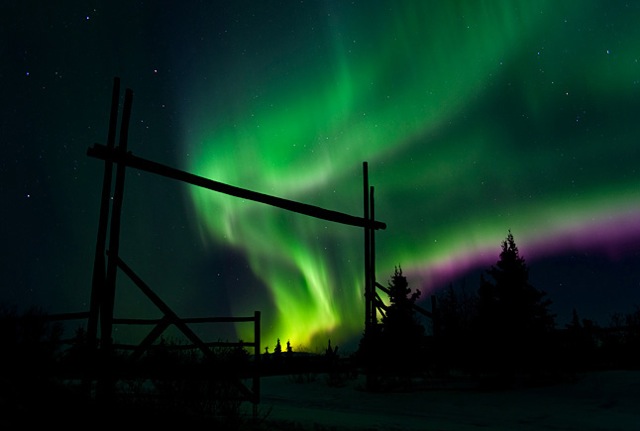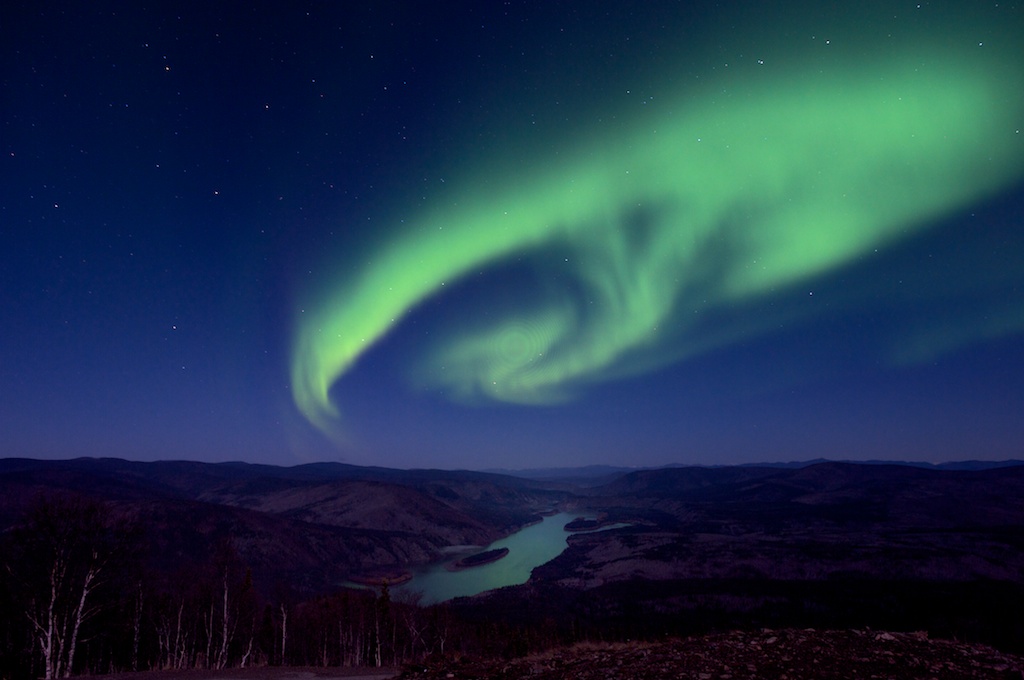
How To Photograph The Northern Lights
Once photographers find out that I travel to the Yukon and Arctic Circle, I’m invariably asked about photographing the Northern Lights, technically known as the Aurora borealis.
There are tons of articles and technical publications related to photographing these miraculous lights that magically appear in the far north at certain times of the year. They are caused by solar winds brushing by the earth’s magnetosphere. The most common color for the lights is green, but under certain conditions the lights can be orange, teal, purple or a combination of these.
Rather than get into a technical discourse, here is some basic information and some personal tips if you are thinking of capturing the Northern (or Southern) lights with your camera. Please note that most of this information is based on personal experience. I’m sure I left some things out, so feel free to suggest your own tips so our readers may benefit from your experience.
Preparation
Time of Year
The far North doesn’t get dark enough for Northern Lights until mid-August. Fall is a great time for Northern Lights because you can take advantage of reflections in lakes and rivers. Winter also works, with the best times being late February, March and April.Consult Websites
Before you go, consult a number of websites,then make your go-no go decision. If you are in the Yukon or Alaska, sites such as www.spaceweather.com, the University of Alaska, Canadian government sites and the National Oceanic and Atmospheric Administration (NOAA) each have sites that predict the aurora (just Google “aurora predictions”). However, keep in mind that aurora prediction is an inexact science and it’s common for sites to be way wrong.Dress Warmly
The first step to getting successful lights images is to dress warmly. Layers is the answer. However cold you anticipate it being, add yet another layer to accommodate the fact that you will essentially be standing still on snow for hours at a time. Use chemical hand warmers for your mittens and boots, as needed. They are available at outdoor stores, as well as big box stores like Costco or BJs. One pair for your gloves or boots will last a good 8 hours. Wear a warm wool hat, under your parka hood. Use two hand protectors; a thin glove so you can operate your camera controls and a warm pair of mittens over them.Use a Tripod
A solid tripod is mandatory. Since you’ll be using very long shutter opening times- up to 30 seconds- the only effective way to get good, sharp Aurora images is by using a tripod.… And a Cable Release
Coupled with your tripod, use a cable release to minimize vibration and shake.… And a Headlamp
You’ll need both hands free to change camera settings and orientation, level, batteries, etc.Bring Extra Batteries
Charge your batteries before you go. Cold weather, especially the extreme cold you’ll encounter in the high north, saps battery power at an incredible rate. Bring extra charged batteries for your camera, headlamp, cable/electronic shutter release and any other battery-powered devices.Take Food
Your body uses lots of calories to keep itself within a narrow temperature range. Take along high fat/high energy foods like nuts and raisins, along with a thermos of hot chocolate to keep yourself nourished.Site selection
Select a site with good foregrounds if that’s important to your composition. That might be a snow covered tree or water. Mountains in the background help. Sometimes moonlight in the image adds a nice dimension.You can always light foreground objects with your headlamp or a flashlight or even your flash, but I find that technique to be unnatural, so use in moderation.
Camera Issues
Using a Point-and-Shoot (PAS)
Most PAS cameras are not up to shooting Northern Lights, so if you're serious about Northern Lights, invest in a DSLR. Some of the newer PAS cameras do offer options which will allow you to get decent aurora shots. However, no matter what type of camera you use you really need to use a tripod for good results.Change to Manual Focus
Read your manual and learn how to put your camera into manual focus mode and then set focus to infinity. Note that some autofocus lenses under- or over-focus at infinity, so it’s a good idea to set up your camera while it is still light and focus it manually on a distant point about 30-50 feet away and be sure to get critical focus. Then, make a mental note of where the pointer on the lens barrel points in relation to the infinity symbol (you may even want to use a permanent marker to mark the spot or a piece of tape). Pre-set your camera to that focus setting, leave it on manual focus and be sure to wear a head lamp. The fewer things you have to fiddle with in the dark, the better your experience- and results- will be.Shoot Wide Open
The main thing is you need a wide angle lens with a fast aperture. The “faster” your lens, the better the results will be, because you’ll be able to use shorter exposure times and capture the lights more crisply.Use a wide angle lens (no more than 28 mm, but preferably 14mm or 20mm… or even less) with a rated f stop of 2.8 or less. A rating of 2.0 or 1.4 is even better because they let in more light, but such lenses are expensive. Check the used market for good deals on manual focus lenses. I checked eBay and found several Nikon and Canon 24mm f2.0 lenses for under $500.
Set Your ISO
Try to use as low an ISO setting as possible. As you increase your ISO, noise increases and will affect your image. Noise in digital cameras is what grain was in film days. On the other hand, if by lowering your ISO you will increase your exposure time to more than 30 seconds, then bump up your ISO a bit. Lights photography is a bit of a balancing act.
Turn on Noise Reduction
Many cameras have a setting that minimizes noise. However, that usually doubles the amount of time it takes to record the image. So, for example, if you leave the shutter open for 20 seconds, it will take an additional 20 seconds for the in-camera computer to reduce the noise. Aurora photography involves a lot of patience and trial-and-error.Don’t Use Filters
Whatever you do, be sure to remove all filters from in front of your lens. Filters can cause interference patterns that will ruin the images (in the sample, below, note the bulls-eye rings in the aurora, just above the river).
Start at 20 Seconds
With your camera on manual focus and set on infinity, trip your shutter and time it to stay open for 20 seconds as a starting point. In some cameras, you will need to set your camera to “Bulb” to accomplish this. Other cameras have pre-set long time intervals to make the job easier.Once the camera is done processing the image, use your screen to assess results. If you can magnify the image in camera, do so and examine the shadowed areas and aurora areas for noise.
If the aurora is too faint, increase the exposure time by 5 seconds and try again. However, try not to go above 30 seconds because you will then get smears in the image instead of distinct starlight points. Those smears are actually star tracks formed by the earth’s rotation. The shorter the exposure, the better because you’ll get better details in the lights, better streaks and better curtains. Boost your ISO to the highest possible without introducing noise.
Stay On It
Just because 25 seconds works at first, doesn’t mean it will work later in the display. Auroras are highly variable. Sometimes they will be faint and ten minutes later they pulse with energy. So, always maintain your vigil and adjust exposures to suit.After the Shoot
Guard Against Condensation
Your cameras will be cold through and through when your shoot is done. Before you come back inside, whether to a warm car or hotel or house, place your cameras and lenses in a sealed plastic bag so condensation forms on the outside of the bag and not on and in your cameras. Condensation inside your camera can ruin the electronic and mechanical components (see my previous blog on condensation: https://blog.lesterpickerphoto.com/2011/01/06/condensation-recommendation/).Good luck with your aurora experiments. Remember, a warm photographer is a happy one.